Professional Engineering Management Report: Unit 35 Module Analysis
VerifiedAdded on 2023/01/19
|10
|3292
|55
Report
AI Summary
This report provides a comprehensive overview of professional engineering management, covering key aspects such as risk evaluation theories and practices, and the elements impacting engineering activities. It delves into the development of an engineering service plan, the determination of necessary design management tools, and the steps involved in effective persuasion, negotiation, and managing group meetings. Furthermore, the report outlines the steps for delivering effective presentations and discusses the social responsibilities of engineers and scientists, highlighting the importance of ethical behavior and professional development within the field. The content is designed to provide a thorough understanding of the practical and theoretical knowledge required for successful engineering project management and professional growth.

Unit 35 - Professional
Engineering Management
1
Engineering Management
1
Paraphrase This Document
Need a fresh take? Get an instant paraphrase of this document with our AI Paraphraser
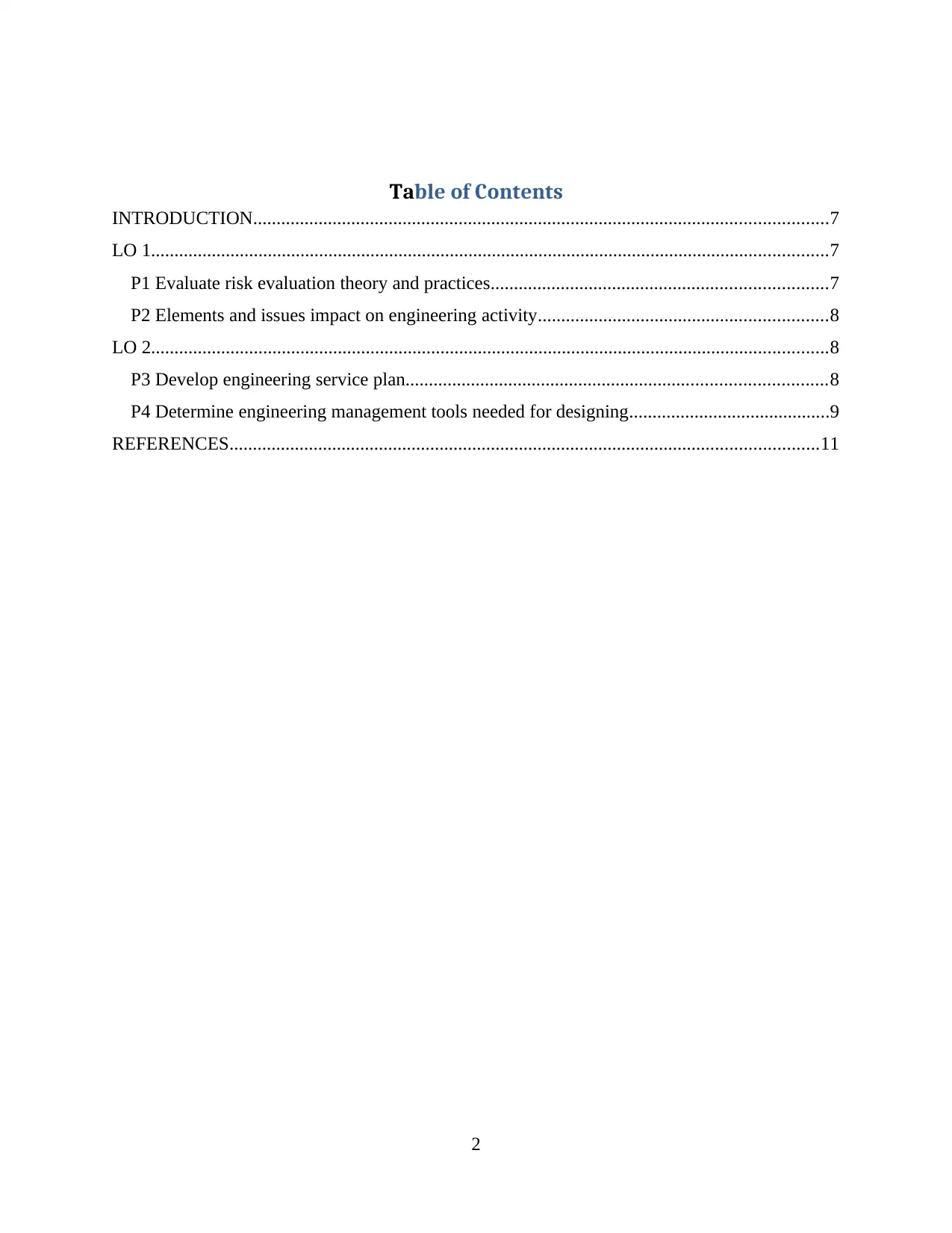
Table of Contents
INTRODUCTION...........................................................................................................................7
LO 1.................................................................................................................................................7
P1 Evaluate risk evaluation theory and practices........................................................................7
P2 Elements and issues impact on engineering activity..............................................................8
LO 2.................................................................................................................................................8
P3 Develop engineering service plan..........................................................................................8
P4 Determine engineering management tools needed for designing...........................................9
REFERENCES..............................................................................................................................11
2
INTRODUCTION...........................................................................................................................7
LO 1.................................................................................................................................................7
P1 Evaluate risk evaluation theory and practices........................................................................7
P2 Elements and issues impact on engineering activity..............................................................8
LO 2.................................................................................................................................................8
P3 Develop engineering service plan..........................................................................................8
P4 Determine engineering management tools needed for designing...........................................9
REFERENCES..............................................................................................................................11
2
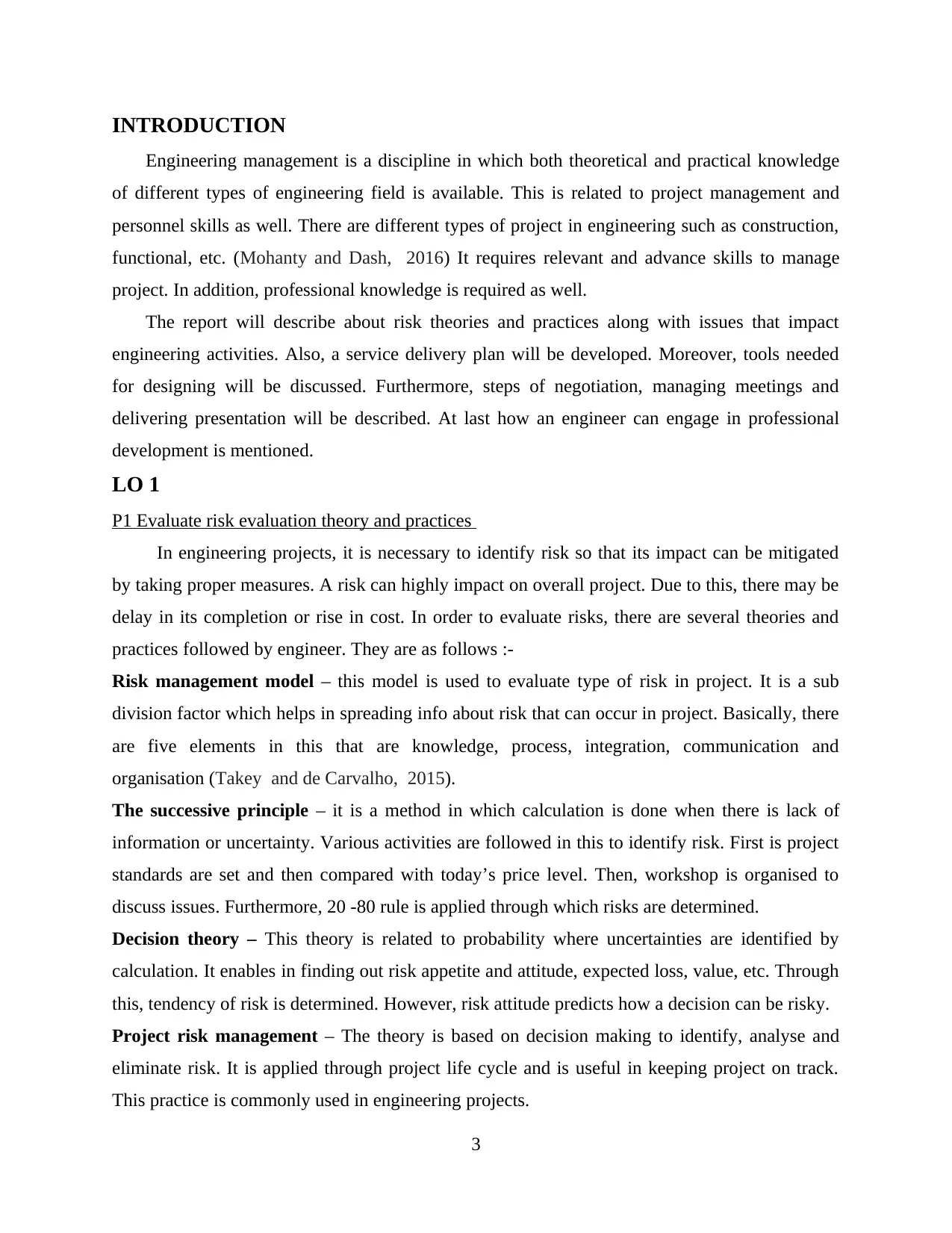
INTRODUCTION
Engineering management is a discipline in which both theoretical and practical knowledge
of different types of engineering field is available. This is related to project management and
personnel skills as well. There are different types of project in engineering such as construction,
functional, etc. (Mohanty and Dash, 2016) It requires relevant and advance skills to manage
project. In addition, professional knowledge is required as well.
The report will describe about risk theories and practices along with issues that impact
engineering activities. Also, a service delivery plan will be developed. Moreover, tools needed
for designing will be discussed. Furthermore, steps of negotiation, managing meetings and
delivering presentation will be described. At last how an engineer can engage in professional
development is mentioned.
LO 1
P1 Evaluate risk evaluation theory and practices
In engineering projects, it is necessary to identify risk so that its impact can be mitigated
by taking proper measures. A risk can highly impact on overall project. Due to this, there may be
delay in its completion or rise in cost. In order to evaluate risks, there are several theories and
practices followed by engineer. They are as follows :-
Risk management model – this model is used to evaluate type of risk in project. It is a sub
division factor which helps in spreading info about risk that can occur in project. Basically, there
are five elements in this that are knowledge, process, integration, communication and
organisation (Takey and de Carvalho, 2015).
The successive principle – it is a method in which calculation is done when there is lack of
information or uncertainty. Various activities are followed in this to identify risk. First is project
standards are set and then compared with today’s price level. Then, workshop is organised to
discuss issues. Furthermore, 20 -80 rule is applied through which risks are determined.
Decision theory – This theory is related to probability where uncertainties are identified by
calculation. It enables in finding out risk appetite and attitude, expected loss, value, etc. Through
this, tendency of risk is determined. However, risk attitude predicts how a decision can be risky.
Project risk management – The theory is based on decision making to identify, analyse and
eliminate risk. It is applied through project life cycle and is useful in keeping project on track.
This practice is commonly used in engineering projects.
3
Engineering management is a discipline in which both theoretical and practical knowledge
of different types of engineering field is available. This is related to project management and
personnel skills as well. There are different types of project in engineering such as construction,
functional, etc. (Mohanty and Dash, 2016) It requires relevant and advance skills to manage
project. In addition, professional knowledge is required as well.
The report will describe about risk theories and practices along with issues that impact
engineering activities. Also, a service delivery plan will be developed. Moreover, tools needed
for designing will be discussed. Furthermore, steps of negotiation, managing meetings and
delivering presentation will be described. At last how an engineer can engage in professional
development is mentioned.
LO 1
P1 Evaluate risk evaluation theory and practices
In engineering projects, it is necessary to identify risk so that its impact can be mitigated
by taking proper measures. A risk can highly impact on overall project. Due to this, there may be
delay in its completion or rise in cost. In order to evaluate risks, there are several theories and
practices followed by engineer. They are as follows :-
Risk management model – this model is used to evaluate type of risk in project. It is a sub
division factor which helps in spreading info about risk that can occur in project. Basically, there
are five elements in this that are knowledge, process, integration, communication and
organisation (Takey and de Carvalho, 2015).
The successive principle – it is a method in which calculation is done when there is lack of
information or uncertainty. Various activities are followed in this to identify risk. First is project
standards are set and then compared with today’s price level. Then, workshop is organised to
discuss issues. Furthermore, 20 -80 rule is applied through which risks are determined.
Decision theory – This theory is related to probability where uncertainties are identified by
calculation. It enables in finding out risk appetite and attitude, expected loss, value, etc. Through
this, tendency of risk is determined. However, risk attitude predicts how a decision can be risky.
Project risk management – The theory is based on decision making to identify, analyse and
eliminate risk. It is applied through project life cycle and is useful in keeping project on track.
This practice is commonly used in engineering projects.
3
⊘ This is a preview!⊘
Do you want full access?
Subscribe today to unlock all pages.

Trusted by 1+ million students worldwide

P2 Elements and issues impact on engineering activity
There are several elements that impact on project activities. Due to this overall project
outcomes are impacted. Beside this, the elements are interrelated to each other, it means affect on
any one activity directly impact other as well. The elements are described below :-
Design criteria - this element is connected to entire project. The activities begin from designing
part. So, it is necessary to design activities properly and in detail so that it is applicable. The
engineer is responsible for it (Rottmann, Sacks and Reeve, 2015). Thus, any change in design
affect entire engineering activities.
Project management procedure – it is also an element that impact on activities. the procedure
refers to how activity is to done, by whom and when. In this, all activities are documented along
with roles, resources, time frame, etc. If procedure is not properly developed it impact on further
activities. Many changes are done in that to provide clarity.
Deadline – It is one of major issue that impact on engineering activity. If a deadline is missed
this led to critical consequences. Here, either quality is compromised or more time is given for
completion. Beside this, there is delay in further activity as well. It also leads to rise in cost for
project.
Budget – this is also an issue that impact on activity. If budget is low then quality of project is
not maintained. Moreover, there is lack of resources to be allocated. So, this directly affect next
activity to be undertaken. Similarly, if budget is more than resources are wasted. There is no
effective utilisation of resources.
LO 2
P3 Develop engineering service plan
The service delivery plan is as follows :-
Focus area Outcomes Metric
Design management To visualise 3 D design and
tracking progress online.
Update blueprints in field with
mark ups
Set of designs
Quality control Inspection is done through
pictures via online App.
Quality standards
4
There are several elements that impact on project activities. Due to this overall project
outcomes are impacted. Beside this, the elements are interrelated to each other, it means affect on
any one activity directly impact other as well. The elements are described below :-
Design criteria - this element is connected to entire project. The activities begin from designing
part. So, it is necessary to design activities properly and in detail so that it is applicable. The
engineer is responsible for it (Rottmann, Sacks and Reeve, 2015). Thus, any change in design
affect entire engineering activities.
Project management procedure – it is also an element that impact on activities. the procedure
refers to how activity is to done, by whom and when. In this, all activities are documented along
with roles, resources, time frame, etc. If procedure is not properly developed it impact on further
activities. Many changes are done in that to provide clarity.
Deadline – It is one of major issue that impact on engineering activity. If a deadline is missed
this led to critical consequences. Here, either quality is compromised or more time is given for
completion. Beside this, there is delay in further activity as well. It also leads to rise in cost for
project.
Budget – this is also an issue that impact on activity. If budget is low then quality of project is
not maintained. Moreover, there is lack of resources to be allocated. So, this directly affect next
activity to be undertaken. Similarly, if budget is more than resources are wasted. There is no
effective utilisation of resources.
LO 2
P3 Develop engineering service plan
The service delivery plan is as follows :-
Focus area Outcomes Metric
Design management To visualise 3 D design and
tracking progress online.
Update blueprints in field with
mark ups
Set of designs
Quality control Inspection is done through
pictures via online App.
Quality standards
4
Paraphrase This Document
Need a fresh take? Get an instant paraphrase of this document with our AI Paraphraser
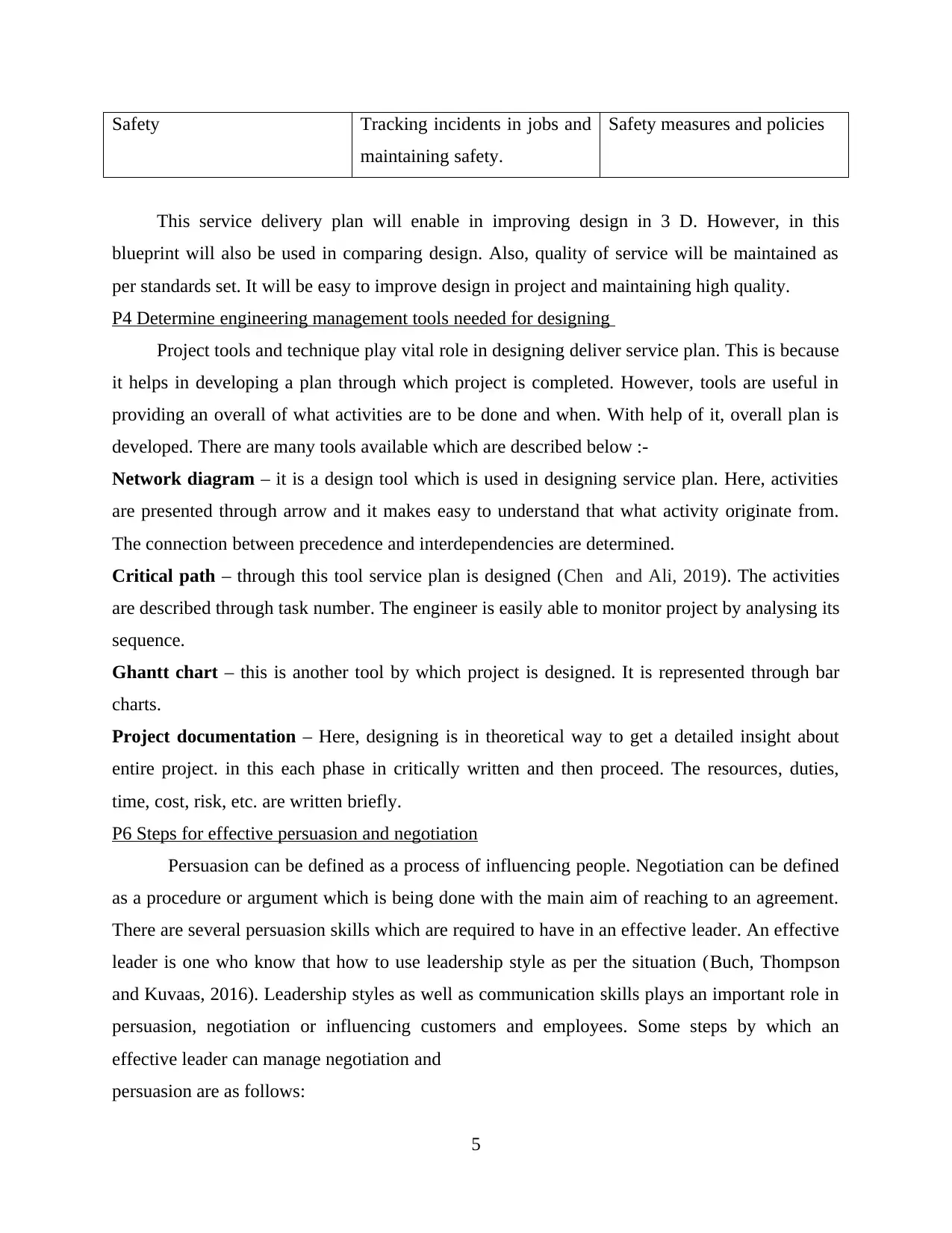
Safety Tracking incidents in jobs and
maintaining safety.
Safety measures and policies
This service delivery plan will enable in improving design in 3 D. However, in this
blueprint will also be used in comparing design. Also, quality of service will be maintained as
per standards set. It will be easy to improve design in project and maintaining high quality.
P4 Determine engineering management tools needed for designing
Project tools and technique play vital role in designing deliver service plan. This is because
it helps in developing a plan through which project is completed. However, tools are useful in
providing an overall of what activities are to be done and when. With help of it, overall plan is
developed. There are many tools available which are described below :-
Network diagram – it is a design tool which is used in designing service plan. Here, activities
are presented through arrow and it makes easy to understand that what activity originate from.
The connection between precedence and interdependencies are determined.
Critical path – through this tool service plan is designed (Chen and Ali, 2019). The activities
are described through task number. The engineer is easily able to monitor project by analysing its
sequence.
Ghantt chart – this is another tool by which project is designed. It is represented through bar
charts.
Project documentation – Here, designing is in theoretical way to get a detailed insight about
entire project. in this each phase in critically written and then proceed. The resources, duties,
time, cost, risk, etc. are written briefly.
P6 Steps for effective persuasion and negotiation
Persuasion can be defined as a process of influencing people. Negotiation can be defined
as a procedure or argument which is being done with the main aim of reaching to an agreement.
There are several persuasion skills which are required to have in an effective leader. An effective
leader is one who know that how to use leadership style as per the situation (Buch, Thompson
and Kuvaas, 2016). Leadership styles as well as communication skills plays an important role in
persuasion, negotiation or influencing customers and employees. Some steps by which an
effective leader can manage negotiation and
persuasion are as follows:
5
maintaining safety.
Safety measures and policies
This service delivery plan will enable in improving design in 3 D. However, in this
blueprint will also be used in comparing design. Also, quality of service will be maintained as
per standards set. It will be easy to improve design in project and maintaining high quality.
P4 Determine engineering management tools needed for designing
Project tools and technique play vital role in designing deliver service plan. This is because
it helps in developing a plan through which project is completed. However, tools are useful in
providing an overall of what activities are to be done and when. With help of it, overall plan is
developed. There are many tools available which are described below :-
Network diagram – it is a design tool which is used in designing service plan. Here, activities
are presented through arrow and it makes easy to understand that what activity originate from.
The connection between precedence and interdependencies are determined.
Critical path – through this tool service plan is designed (Chen and Ali, 2019). The activities
are described through task number. The engineer is easily able to monitor project by analysing its
sequence.
Ghantt chart – this is another tool by which project is designed. It is represented through bar
charts.
Project documentation – Here, designing is in theoretical way to get a detailed insight about
entire project. in this each phase in critically written and then proceed. The resources, duties,
time, cost, risk, etc. are written briefly.
P6 Steps for effective persuasion and negotiation
Persuasion can be defined as a process of influencing people. Negotiation can be defined
as a procedure or argument which is being done with the main aim of reaching to an agreement.
There are several persuasion skills which are required to have in an effective leader. An effective
leader is one who know that how to use leadership style as per the situation (Buch, Thompson
and Kuvaas, 2016). Leadership styles as well as communication skills plays an important role in
persuasion, negotiation or influencing customers and employees. Some steps by which an
effective leader can manage negotiation and
persuasion are as follows:
5

Establishing credibility: An effective leader by using strategic style, try to listen
employees suggestions and also develop an environment of trust in which all employees feel that
their opinions are valued. Collect several data for making the final decision that may be support
and contradict arguments.
Understanding people: After creating an effective and trust environment, an effective
and strategic leader set a common goal that is beneficial for audience and the company as well.
For understanding people, it is important to have an effective communication skill. With
communication and the way of talking skill, they can gather any type of information.
Effective communication: For persuasion, a leader require giving authenticate source
and reason which shows reliability and effectiveness. An effective communication help a leader
and an individual to influence people and also allows an individual to speak concisely (Raley and
et.al., 2017).
So, it can be said that an effective leadership style plays an important role. By following
all these steps, leader can make all employees able to work whether in a team or individually. An
effective communication and leadership style also make an individual able to take the right
decision and get the work done from employees by influencing them.
P7 Steps for managing effective group meeting
There is a requirement of an effective group communication skills in managing an
effective group meeting. Some steps of managing group meeting which shows the importance of
group communication skills are described as follows:
Starting on the time: The main point and important step of managing an effective group
meeting is to start on the time. For this step there is a requirement to have a time management
and an effective leadership skills. An effective style of leadership can make all people bind to
come on the time in a meeting that can save their time.
Open discussion: Open discussion means to give opportunity to all members to speak
about the topic. Some members are introvert and fell shy to share and giving suggestions. But
with having an effective group communication skills, an individual and a leader can make all
members comfortable to speak about the topic. An individual who has group communication
skill listen to everyone and try to work with all type of people in an effective manner (Levi,
2015).
Delegate leadership: Some qualities of a leader who posses a group communication
6
employees suggestions and also develop an environment of trust in which all employees feel that
their opinions are valued. Collect several data for making the final decision that may be support
and contradict arguments.
Understanding people: After creating an effective and trust environment, an effective
and strategic leader set a common goal that is beneficial for audience and the company as well.
For understanding people, it is important to have an effective communication skill. With
communication and the way of talking skill, they can gather any type of information.
Effective communication: For persuasion, a leader require giving authenticate source
and reason which shows reliability and effectiveness. An effective communication help a leader
and an individual to influence people and also allows an individual to speak concisely (Raley and
et.al., 2017).
So, it can be said that an effective leadership style plays an important role. By following
all these steps, leader can make all employees able to work whether in a team or individually. An
effective communication and leadership style also make an individual able to take the right
decision and get the work done from employees by influencing them.
P7 Steps for managing effective group meeting
There is a requirement of an effective group communication skills in managing an
effective group meeting. Some steps of managing group meeting which shows the importance of
group communication skills are described as follows:
Starting on the time: The main point and important step of managing an effective group
meeting is to start on the time. For this step there is a requirement to have a time management
and an effective leadership skills. An effective style of leadership can make all people bind to
come on the time in a meeting that can save their time.
Open discussion: Open discussion means to give opportunity to all members to speak
about the topic. Some members are introvert and fell shy to share and giving suggestions. But
with having an effective group communication skills, an individual and a leader can make all
members comfortable to speak about the topic. An individual who has group communication
skill listen to everyone and try to work with all type of people in an effective manner (Levi,
2015).
Delegate leadership: Some qualities of a leader who posses a group communication
6
⊘ This is a preview!⊘
Do you want full access?
Subscribe today to unlock all pages.

Trusted by 1+ million students worldwide
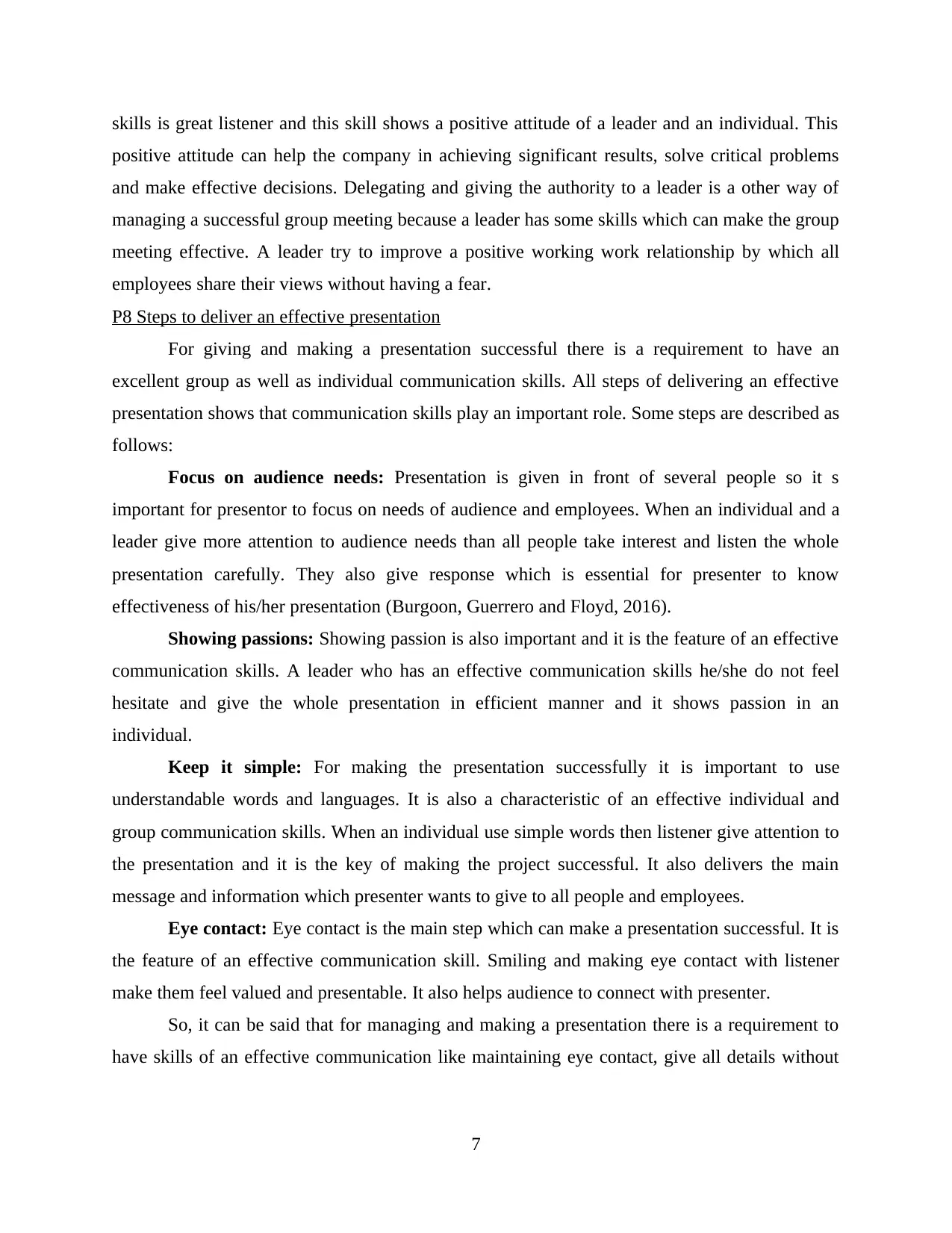
skills is great listener and this skill shows a positive attitude of a leader and an individual. This
positive attitude can help the company in achieving significant results, solve critical problems
and make effective decisions. Delegating and giving the authority to a leader is a other way of
managing a successful group meeting because a leader has some skills which can make the group
meeting effective. A leader try to improve a positive working work relationship by which all
employees share their views without having a fear.
P8 Steps to deliver an effective presentation
For giving and making a presentation successful there is a requirement to have an
excellent group as well as individual communication skills. All steps of delivering an effective
presentation shows that communication skills play an important role. Some steps are described as
follows:
Focus on audience needs: Presentation is given in front of several people so it s
important for presentor to focus on needs of audience and employees. When an individual and a
leader give more attention to audience needs than all people take interest and listen the whole
presentation carefully. They also give response which is essential for presenter to know
effectiveness of his/her presentation (Burgoon, Guerrero and Floyd, 2016).
Showing passions: Showing passion is also important and it is the feature of an effective
communication skills. A leader who has an effective communication skills he/she do not feel
hesitate and give the whole presentation in efficient manner and it shows passion in an
individual.
Keep it simple: For making the presentation successfully it is important to use
understandable words and languages. It is also a characteristic of an effective individual and
group communication skills. When an individual use simple words then listener give attention to
the presentation and it is the key of making the project successful. It also delivers the main
message and information which presenter wants to give to all people and employees.
Eye contact: Eye contact is the main step which can make a presentation successful. It is
the feature of an effective communication skill. Smiling and making eye contact with listener
make them feel valued and presentable. It also helps audience to connect with presenter.
So, it can be said that for managing and making a presentation there is a requirement to
have skills of an effective communication like maintaining eye contact, give all details without
7
positive attitude can help the company in achieving significant results, solve critical problems
and make effective decisions. Delegating and giving the authority to a leader is a other way of
managing a successful group meeting because a leader has some skills which can make the group
meeting effective. A leader try to improve a positive working work relationship by which all
employees share their views without having a fear.
P8 Steps to deliver an effective presentation
For giving and making a presentation successful there is a requirement to have an
excellent group as well as individual communication skills. All steps of delivering an effective
presentation shows that communication skills play an important role. Some steps are described as
follows:
Focus on audience needs: Presentation is given in front of several people so it s
important for presentor to focus on needs of audience and employees. When an individual and a
leader give more attention to audience needs than all people take interest and listen the whole
presentation carefully. They also give response which is essential for presenter to know
effectiveness of his/her presentation (Burgoon, Guerrero and Floyd, 2016).
Showing passions: Showing passion is also important and it is the feature of an effective
communication skills. A leader who has an effective communication skills he/she do not feel
hesitate and give the whole presentation in efficient manner and it shows passion in an
individual.
Keep it simple: For making the presentation successfully it is important to use
understandable words and languages. It is also a characteristic of an effective individual and
group communication skills. When an individual use simple words then listener give attention to
the presentation and it is the key of making the project successful. It also delivers the main
message and information which presenter wants to give to all people and employees.
Eye contact: Eye contact is the main step which can make a presentation successful. It is
the feature of an effective communication skill. Smiling and making eye contact with listener
make them feel valued and presentable. It also helps audience to connect with presenter.
So, it can be said that for managing and making a presentation there is a requirement to
have skills of an effective communication like maintaining eye contact, give all details without
7
Paraphrase This Document
Need a fresh take? Get an instant paraphrase of this document with our AI Paraphraser
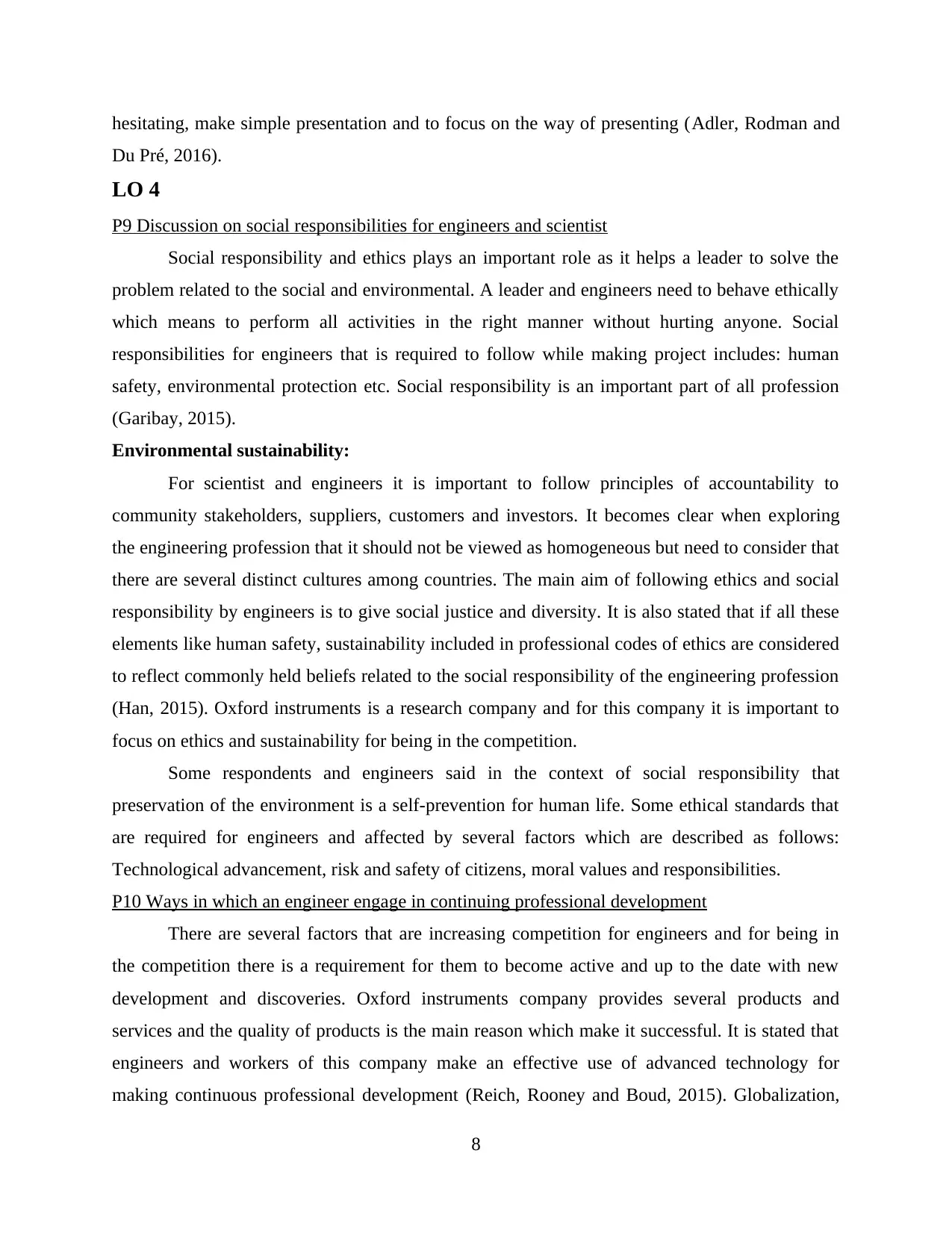
hesitating, make simple presentation and to focus on the way of presenting (Adler, Rodman and
Du Pré, 2016).
LO 4
P9 Discussion on social responsibilities for engineers and scientist
Social responsibility and ethics plays an important role as it helps a leader to solve the
problem related to the social and environmental. A leader and engineers need to behave ethically
which means to perform all activities in the right manner without hurting anyone. Social
responsibilities for engineers that is required to follow while making project includes: human
safety, environmental protection etc. Social responsibility is an important part of all profession
(Garibay, 2015).
Environmental sustainability:
For scientist and engineers it is important to follow principles of accountability to
community stakeholders, suppliers, customers and investors. It becomes clear when exploring
the engineering profession that it should not be viewed as homogeneous but need to consider that
there are several distinct cultures among countries. The main aim of following ethics and social
responsibility by engineers is to give social justice and diversity. It is also stated that if all these
elements like human safety, sustainability included in professional codes of ethics are considered
to reflect commonly held beliefs related to the social responsibility of the engineering profession
(Han, 2015). Oxford instruments is a research company and for this company it is important to
focus on ethics and sustainability for being in the competition.
Some respondents and engineers said in the context of social responsibility that
preservation of the environment is a self-prevention for human life. Some ethical standards that
are required for engineers and affected by several factors which are described as follows:
Technological advancement, risk and safety of citizens, moral values and responsibilities.
P10 Ways in which an engineer engage in continuing professional development
There are several factors that are increasing competition for engineers and for being in
the competition there is a requirement for them to become active and up to the date with new
development and discoveries. Oxford instruments company provides several products and
services and the quality of products is the main reason which make it successful. It is stated that
engineers and workers of this company make an effective use of advanced technology for
making continuous professional development (Reich, Rooney and Boud, 2015). Globalization,
8
Du Pré, 2016).
LO 4
P9 Discussion on social responsibilities for engineers and scientist
Social responsibility and ethics plays an important role as it helps a leader to solve the
problem related to the social and environmental. A leader and engineers need to behave ethically
which means to perform all activities in the right manner without hurting anyone. Social
responsibilities for engineers that is required to follow while making project includes: human
safety, environmental protection etc. Social responsibility is an important part of all profession
(Garibay, 2015).
Environmental sustainability:
For scientist and engineers it is important to follow principles of accountability to
community stakeholders, suppliers, customers and investors. It becomes clear when exploring
the engineering profession that it should not be viewed as homogeneous but need to consider that
there are several distinct cultures among countries. The main aim of following ethics and social
responsibility by engineers is to give social justice and diversity. It is also stated that if all these
elements like human safety, sustainability included in professional codes of ethics are considered
to reflect commonly held beliefs related to the social responsibility of the engineering profession
(Han, 2015). Oxford instruments is a research company and for this company it is important to
focus on ethics and sustainability for being in the competition.
Some respondents and engineers said in the context of social responsibility that
preservation of the environment is a self-prevention for human life. Some ethical standards that
are required for engineers and affected by several factors which are described as follows:
Technological advancement, risk and safety of citizens, moral values and responsibilities.
P10 Ways in which an engineer engage in continuing professional development
There are several factors that are increasing competition for engineers and for being in
the competition there is a requirement for them to become active and up to the date with new
development and discoveries. Oxford instruments company provides several products and
services and the quality of products is the main reason which make it successful. It is stated that
engineers and workers of this company make an effective use of advanced technology for
making continuous professional development (Reich, Rooney and Boud, 2015). Globalization,
8
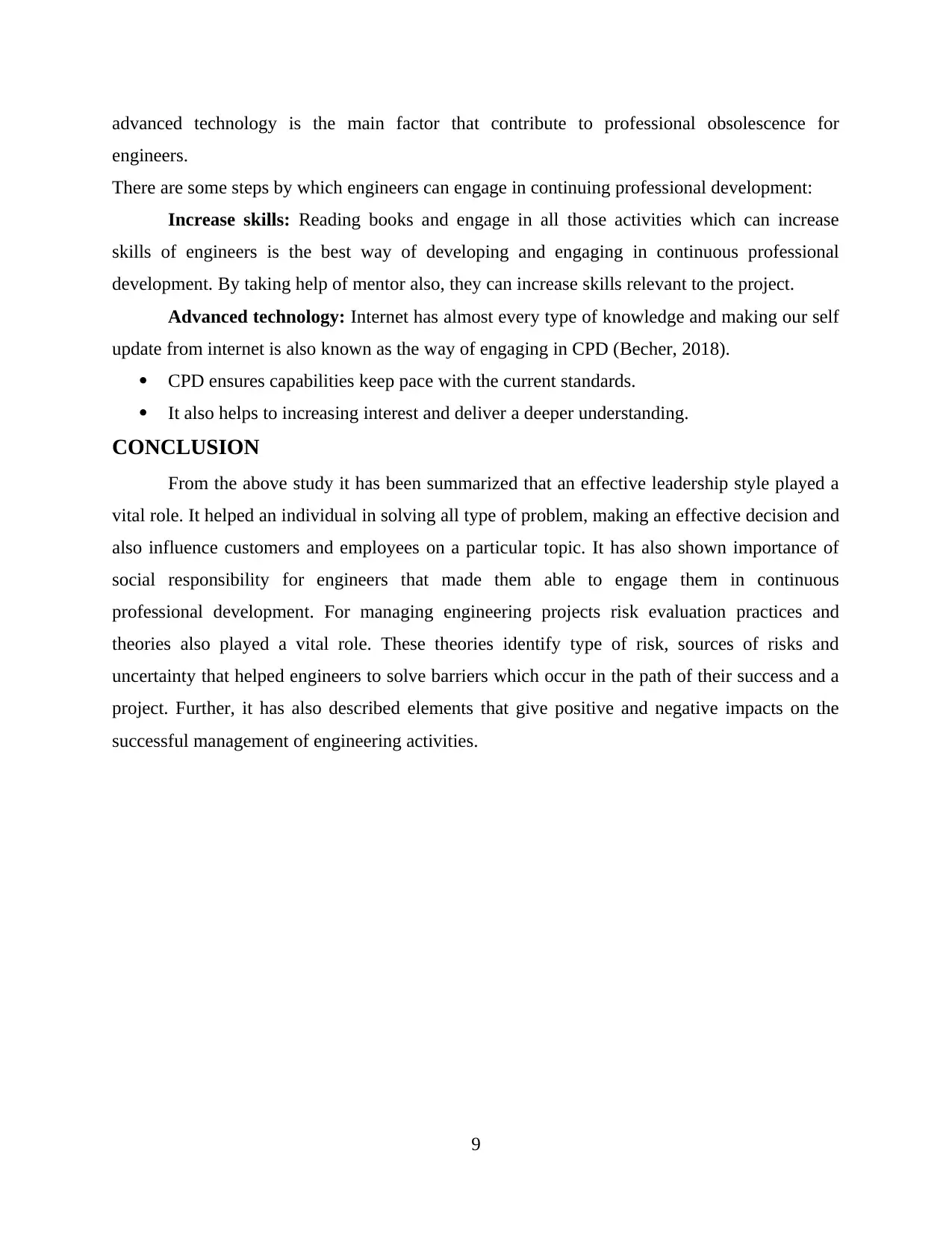
advanced technology is the main factor that contribute to professional obsolescence for
engineers.
There are some steps by which engineers can engage in continuing professional development:
Increase skills: Reading books and engage in all those activities which can increase
skills of engineers is the best way of developing and engaging in continuous professional
development. By taking help of mentor also, they can increase skills relevant to the project.
Advanced technology: Internet has almost every type of knowledge and making our self
update from internet is also known as the way of engaging in CPD (Becher, 2018).
CPD ensures capabilities keep pace with the current standards.
It also helps to increasing interest and deliver a deeper understanding.
CONCLUSION
From the above study it has been summarized that an effective leadership style played a
vital role. It helped an individual in solving all type of problem, making an effective decision and
also influence customers and employees on a particular topic. It has also shown importance of
social responsibility for engineers that made them able to engage them in continuous
professional development. For managing engineering projects risk evaluation practices and
theories also played a vital role. These theories identify type of risk, sources of risks and
uncertainty that helped engineers to solve barriers which occur in the path of their success and a
project. Further, it has also described elements that give positive and negative impacts on the
successful management of engineering activities.
9
engineers.
There are some steps by which engineers can engage in continuing professional development:
Increase skills: Reading books and engage in all those activities which can increase
skills of engineers is the best way of developing and engaging in continuous professional
development. By taking help of mentor also, they can increase skills relevant to the project.
Advanced technology: Internet has almost every type of knowledge and making our self
update from internet is also known as the way of engaging in CPD (Becher, 2018).
CPD ensures capabilities keep pace with the current standards.
It also helps to increasing interest and deliver a deeper understanding.
CONCLUSION
From the above study it has been summarized that an effective leadership style played a
vital role. It helped an individual in solving all type of problem, making an effective decision and
also influence customers and employees on a particular topic. It has also shown importance of
social responsibility for engineers that made them able to engage them in continuous
professional development. For managing engineering projects risk evaluation practices and
theories also played a vital role. These theories identify type of risk, sources of risks and
uncertainty that helped engineers to solve barriers which occur in the path of their success and a
project. Further, it has also described elements that give positive and negative impacts on the
successful management of engineering activities.
9
⊘ This is a preview!⊘
Do you want full access?
Subscribe today to unlock all pages.

Trusted by 1+ million students worldwide

REFERENCES
Books and journals
Adler, R.B., Rodman, G.R. and Du Pré, A., 2016. Understanding human communication (Vol.
10). Oxford University Press.
Becher, T., 2018. Professional practices: Commitment and capability in a changing
environment. Routledge.
Buch, R., Thompson, G. and Kuvaas, B., 2016. Transactional leader–member exchange
relationships and followers’ work performance: The moderating role of leaders’
political skill. Journal of Leadership & Organizational Studies. 23(4). pp.456-466.
Burgoon, J.K., Guerrero, L.K. and Floyd, K., 2016. Nonverbal communication. Routledge.
Chen, S. and Ali, Y., 2019, May. Civil engineers invited to help build on a century of women in
professional engineering. In Proceedings of the Institution of Civil Engineers-Civil
Engineering (Vol. 172, No. 2, pp. 51-51). Thomas Telford Ltd.
Garibay, J.C., 2015. STEM students’ social agency and views on working for social change: Are
STEM disciplines developing socially and civically responsible students?. Journal of
Research in Science Teaching. 52(5). pp.610-632.
Han, H., 2015. Virtue ethics, positive psychology, and a new model of science and engineering
ethics education. Science and Engineering Ethics. 21(2). pp.441-460.
Levi, D., 2015. Group dynamics for teams. Sage Publications.
Mohanty, A. and Dash, D., 2016. Engineering education in India: Preparation of professional
engineering educators. Journal of human resource and sustainability studies, 4(02), p.92.
Raley, J. and et.al., 2017. The role of communication during trauma activations: investigating the
need for team and leader communication training. Journal of surgical education. 74(1).
pp.173-179.
Reich, A., Rooney, D. and Boud, D., 2015. Dilemmas in continuing professional learning:
learning inscribed in frameworks or elicited from practice. Studies in Continuing
Education. 37(2). pp.131-141.
Rottmann, C., Sacks, R. and Reeve, D., 2015. Engineering leadership: Grounding leadership
theory in engineers’ professional identities. Leadership. 11(3). pp.351-373.
Takey, S.M. and de Carvalho, M.M., 2015. Competency mapping in project management: An
action research study in an engineering company. International Journal of Project
Management. 33(4). pp.784-796.
10
Books and journals
Adler, R.B., Rodman, G.R. and Du Pré, A., 2016. Understanding human communication (Vol.
10). Oxford University Press.
Becher, T., 2018. Professional practices: Commitment and capability in a changing
environment. Routledge.
Buch, R., Thompson, G. and Kuvaas, B., 2016. Transactional leader–member exchange
relationships and followers’ work performance: The moderating role of leaders’
political skill. Journal of Leadership & Organizational Studies. 23(4). pp.456-466.
Burgoon, J.K., Guerrero, L.K. and Floyd, K., 2016. Nonverbal communication. Routledge.
Chen, S. and Ali, Y., 2019, May. Civil engineers invited to help build on a century of women in
professional engineering. In Proceedings of the Institution of Civil Engineers-Civil
Engineering (Vol. 172, No. 2, pp. 51-51). Thomas Telford Ltd.
Garibay, J.C., 2015. STEM students’ social agency and views on working for social change: Are
STEM disciplines developing socially and civically responsible students?. Journal of
Research in Science Teaching. 52(5). pp.610-632.
Han, H., 2015. Virtue ethics, positive psychology, and a new model of science and engineering
ethics education. Science and Engineering Ethics. 21(2). pp.441-460.
Levi, D., 2015. Group dynamics for teams. Sage Publications.
Mohanty, A. and Dash, D., 2016. Engineering education in India: Preparation of professional
engineering educators. Journal of human resource and sustainability studies, 4(02), p.92.
Raley, J. and et.al., 2017. The role of communication during trauma activations: investigating the
need for team and leader communication training. Journal of surgical education. 74(1).
pp.173-179.
Reich, A., Rooney, D. and Boud, D., 2015. Dilemmas in continuing professional learning:
learning inscribed in frameworks or elicited from practice. Studies in Continuing
Education. 37(2). pp.131-141.
Rottmann, C., Sacks, R. and Reeve, D., 2015. Engineering leadership: Grounding leadership
theory in engineers’ professional identities. Leadership. 11(3). pp.351-373.
Takey, S.M. and de Carvalho, M.M., 2015. Competency mapping in project management: An
action research study in an engineering company. International Journal of Project
Management. 33(4). pp.784-796.
10
1 out of 10
Related Documents
Your All-in-One AI-Powered Toolkit for Academic Success.
+13062052269
info@desklib.com
Available 24*7 on WhatsApp / Email
![[object Object]](/_next/static/media/star-bottom.7253800d.svg)
Unlock your academic potential
Copyright © 2020–2025 A2Z Services. All Rights Reserved. Developed and managed by ZUCOL.





